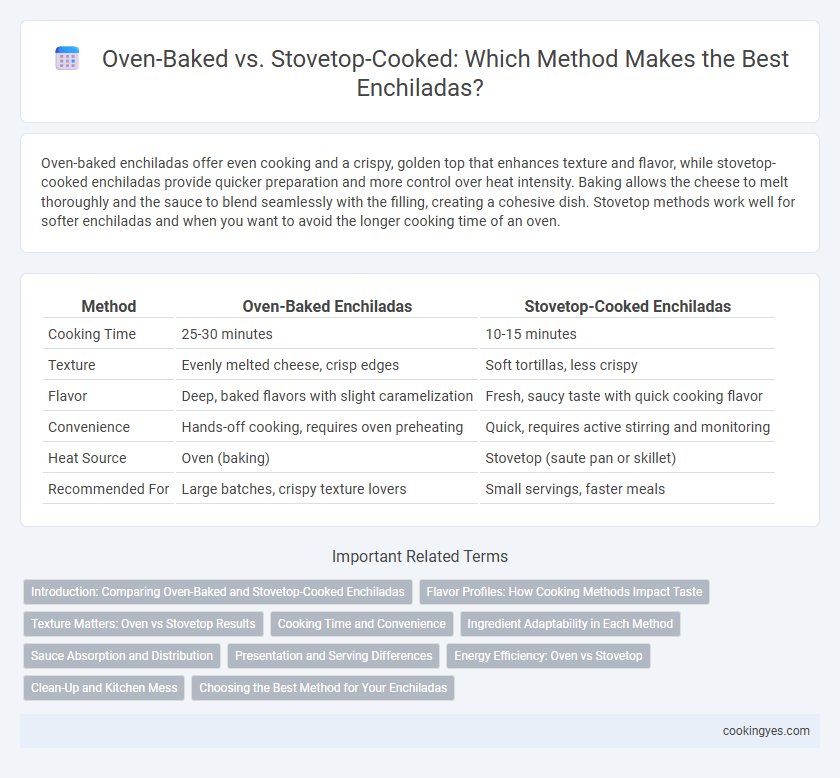Oven-baked enchiladas offer even cooking and a crispy, golden top that enhances texture and flavor, while stovetop-cooked enchiladas provide quicker preparation and more control over heat intensity. Baking allows the cheese to melt thoroughly and the sauce to blend seamlessly with the filling, creating a cohesive dish. Stovetop methods work well for softer enchiladas and when you want to avoid the longer cooking time of an oven.
Table of Comparison
| Method | Oven-Baked Enchiladas | Stovetop-Cooked Enchiladas |
|---|---|---|
| Cooking Time | 25-30 minutes | 10-15 minutes |
| Texture | Evenly melted cheese, crisp edges | Soft tortillas, less crispy |
| Flavor | Deep, baked flavors with slight caramelization | Fresh, saucy taste with quick cooking flavor |
| Convenience | Hands-off cooking, requires oven preheating | Quick, requires active stirring and monitoring |
| Heat Source | Oven (baking) | Stovetop (saute pan or skillet) |
| Recommended For | Large batches, crispy texture lovers | Small servings, faster meals |
Introduction: Comparing Oven-Baked and Stovetop-Cooked Enchiladas
Oven-baked enchiladas offer a crisp, golden topping with melted cheese evenly distributed, enhancing texture and flavor depth through slow, consistent heat. Stovetop-cooked enchiladas provide a quicker preparation method with a softer tortilla and saucier consistency, ideal for retaining moisture. Choosing between these methods depends on desired texture and cooking time preferences.
Flavor Profiles: How Cooking Methods Impact Taste
Oven-baked enchiladas develop a rich, melded flavor as the heat evenly melts cheese and simmers the sauce, creating a savory depth with slightly crispy edges. Stovetop-cooked enchiladas maintain more distinct layers, preserving the freshness of individual ingredients and delivering a brighter, more vibrant taste. Choosing between methods depends on whether a cohesive, hearty flavor or a fresh, textured experience is preferred.
Texture Matters: Oven vs Stovetop Results
Oven-baked enchiladas develop a crispy, golden top layer while allowing the cheese to melt evenly and the sauce to thicken, resulting in a richer, cohesive texture. In contrast, stovetop-cooked enchiladas maintain a softer, more pliable tortilla with a moister filling due to less exposure to dry heat. Texture preferences tend to favor oven-baked for a firmer bite and stovetop for a tender, saucier experience.
Cooking Time and Convenience
Oven-baking enchiladas typically requires 20 to 30 minutes, allowing for even heat distribution that ensures melted cheese and fully cooked fillings, making it ideal for batch preparation. Stovetop cooking significantly reduces cooking time to about 10 to 15 minutes, offering greater convenience for quick meals but may require constant attention to prevent sticking or uneven heating. Choosing between oven and stovetop methods depends on prioritizing thorough cooking and hands-off convenience versus speed and direct control over the cooking process.
Ingredient Adaptability in Each Method
Oven-baked enchiladas allow for even cooking and better melting of cheese, accommodating ingredients like layered vegetables, shredded meats, and sauces that benefit from slow heat distribution. Stovetop-cooked enchiladas offer rapid cooking suited for softer fillings such as beans and cheese, with the flexibility to control sauce thickness and texture more precisely. Both methods support ingredient adaptability, but oven baking excels in melding complex flavors and textures, while stovetop cooking provides quicker, more customizable results.
Sauce Absorption and Distribution
Oven-baked enchiladas allow the sauce to evenly permeate the layers, resulting in a uniform absorption that enhances flavor complexity throughout the dish. In contrast, stovetop-cooked enchiladas often experience uneven sauce distribution, as quicker heating limits the sauce's time to soak into the tortillas and fillings. Optimal sauce absorption and consistent distribution are achieved through baking at moderate temperatures, typically around 350degF for 20-25 minutes, ensuring a moist texture and balanced taste.
Presentation and Serving Differences
Oven-baked enchiladas develop a golden, slightly crispy top layer of melted cheese that enhances visual appeal and allows for easy portioning during serving. Stovetop-cooked enchiladas retain a softer texture and are typically served directly from the pan, creating a more rustic and casual presentation. The oven-baked method often suits plated dinners with defined servings, while stovetop preparation encourages a communal, family-style meal experience.
Energy Efficiency: Oven vs Stovetop
Oven-baked enchiladas typically consume more energy due to longer preheating and cooking times compared to stovetop methods, which heat food directly and more quickly. Stove burners convert energy more efficiently into direct heat, reducing overall cooking duration and energy usage for enchiladas. Choosing stovetop cooking can result in lower energy consumption while still achieving evenly heated, flavorful enchiladas.
Clean-Up and Kitchen Mess
Oven-baked enchiladas often result in less stovetop splatter, containing sauces within the baking dish, which simplifies cleanup by minimizing grease and spills. Stovetop-cooked enchiladas can create more mess, with sauce simmering and bubbling over, increasing the need for frequent wiping of burners and countertops. Choosing oven-baking reduces kitchen mess and cleanup time, making it a more efficient option for maintaining kitchen hygiene.
Choosing the Best Method for Your Enchiladas
Oven-baked enchiladas offer a crispy texture and evenly melted cheese, enhancing the rich flavors of traditional Mexican sauces. Stovetop-cooked enchiladas provide a quicker preparation time and maintain a softer, more pliable tortilla texture, ideal for a softer bite. Selecting the best method depends on your desired texture and time constraints, with oven-baking preferred for depth of flavor and stovetop cooking suited for speedy, tender results.
Oven-baked vs Stovetop-cooked for enchiladas Infographic

 cookingyes.com
cookingyes.com